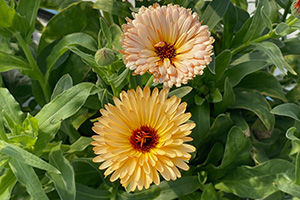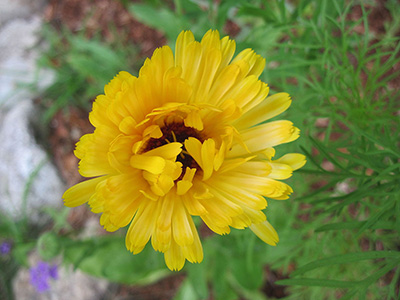Calendula
Calendula is one of the most reliable cool-season annuals.

Not only do its brightly-colored flowers make it a cheerful addition to the garden, calendula (Calendula officinalis) also has an interesting history. Its flower petals have been used throughout history medicinally, as a religious symbol, and as a dye.
Dried calendula petals can be ground up to produce a pale yellow dye that can be used on fabrics or in cooking; early American colonists actually used calendula to color butter and cheese.
Calendula has also been valued by some for its therapeutic use in a salve for burns and cuts, or for generally hydrating the skin.
Characteristics
Calendula produces cheerful, daisy-like flowers. These flowers are either single or double and can be yellow or orange. The flowers are edible and can be used whole as a garnish, or dried and ground for use as a culinary dye. It’s suggested that you taste the flowers before cooking with them, as some people find the taste bitter.
Calendula, sometimes called pot marigold, has a dense, rounded shape and grows to a height and spread of about 1 to 1.5 feet. It works well in mass plantings as an annual groundcover, either in an open bed or beneath a small tree. As its other common name would imply, it also does well in containers. Calendula blossoms attract butterflies and keep well as cut flowers.
Planting and Care

Calendula can be planted in full sun or partial shade, spaced 12 to 18 inches apart, in well-drained soil. It can be difficult to find calendula transplants, so your best bet is to look for seeds.
This plant self-sows, so you may find yourself with some bonus calendulas popping up next year. You can help prevent this by deadheading spent flowers before they go to seed. Deadheading will also help your pot marigold continue to put out new flowers. If you do find yourself with a few “volunteer” calendulas, you can dig up the seedlings and plant them elsewhere in the landscape or pass them along to a friend.
Don’t limit yourself to the flowerbed, though—calendula looks great in the winter vegetable garden, bringing a spot of color next to the collards and cabbage.
Also on Gardening Solutions
- Add a Thrilling Porch Planter for Fall
- Annual Flowers
- Cut Flowers for Cool Weather
- Edible Flowers
- Garden Medicinals
- Winter Annuals
